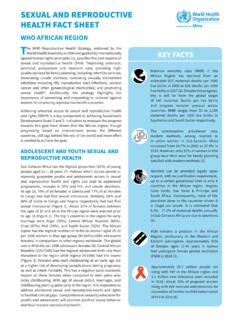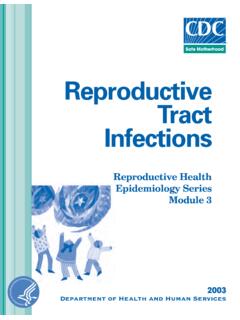Transcription of Human Physiology/The female reproductive system
1 Human Physiology/The female reproductive system1 Human Physiology/The female reproductivesystem The male reproductive system Human physiology Pregnancy and birth Homeostasis Cells Integumentary Nervous Senses Muscular Blood Cardiovascular Immune Urinary Respiratory Gastrointestinal Nutrition Endocrine Reproduction (male) Reproduction ( female ) Pregnancy Genetics Development AnswersIntroductionAll living things reproduce. This is something that sets the living apart from non-living. Even though thereproductive system is essential to keeping a species alive, it is not essential to keeping an individual alive.
2 Thischapter describes the different parts of the female reproductive system : the organs involved in the process ofreproduction, hormones that regulate a woman's body, the menstrual cycle, ovulation and pregnancy, the female 'srole in genetic division, birth control, sexually transmitted diseases and other diseases and can be defined as the process by which an organism continues its species. In the Human reproductiveprocess, two kinds of sex cells ( gametes), are involved: the male gamete (sperm), and the female gamete (egg orovum). These two gametes meet within the female 's uterine tubes located one on each side of the upper pelvic cavity,and begin to create a new individual.
3 The female needs a male to fertilize her egg; she then carries offspring throughpregnancy and between male and female reproductive systemsThe reproductive systems of the male and female have some basic similarities and some specialized are the same in that most of the reproductive organs of both sexes develop from similar embryonic tissue,meaning they are homologous. Both systems have gonads that produce (sperm and egg or ovum) and sex both systems experience maturation of their reproductive organs, which become functional during puberty as aresult of the gonads secreting sex Human male reproductive systemIn short, this is a known list of sexorgans that evolve from the sametissue in a Human Physiology/The female reproductive system2 Cross-sectional diagram of the femalereproductive Male female GonadTestisOvaryMullerian ductAppendix testisFallopian tubesMullerian ductProstatic utricleUterus.
4 ProximalWolffian ductRete testisRete ovariiMesonephric tubulesEfferent ductsEpoophoronWolffian ductEpididymisGartner's ductWolffian ductVas deferensWolffian ductSeminal vesicleWolffian ductProstateSkene's glandsUrogenital sinusBladder, urethraBladder, urethra, distalUrogenital sinusBulbourethral glandBartholin's glandGenital swellingScrotumLabia majoraUrogenital foldsDistal urethraLabia minoraGenital tuberclePenisClitorisPrepuceClitoral hoodBulb of penisVestibular bulbsGlans penisClitoral glansCrus of penisClitoral cruraDifferences between male and female reproductive systemsThe differences between the female and male reproductive systems are based on the functions of each individual'srole in the reproduction cycle.
5 A male who is healthy, and sexually mature, continuously produces sperm. Thedevelopment of women's "eggs" are arrested during fetal development. This means she is born with a predeterminednumber of oocytes and cannot produce new about 5 months gestation, the ovaries contain approximately six to seven million oogonia, which initiate oogonia produce primary oocytes that are arrested in prophase I of meiosis from the time of birth until puberty, during each menstrual cycle, one or several oocytes resume meiosis and undergo their first meioticdivision during ovulation.
6 This results in the production of a secondary oocyte and one polar body. The meioticdivision is arrested in metaphase II. Fertilization triggers completion of the second meiotic division and the result isone ovum and an additional polar Physiology/The female reproductive system3 The ovaries of a newborn baby girl contain about one million oocytes. This number declines to 400,000 to 500,000by the time puberty is reached. On average, 500-1000 oocytes are ovulated during a woman's reproductive a young woman reaches puberty around age 10 to 13, a promary oocyte is discharged from one of the ovariesevery 28 days.
7 This continues until the woman reaches menopause, usually around the age of 50 years. Occytes arepresent at birth, and age as a woman reproductive system Produces eggs (ova) Secretes sex hormones Receives the male spermatazoa during Protects and nourishes the fertilized egg until it is fully developed Delivers fetus through birth canal Provides nourishment to the baby through milk secreted by mammary glands in the breastExternal GenitalsVulvaThe external female genitalia is referred to as vulva. Itconsists of the labia majora and labia minora (whilethese names translate as "large" and "small" lips, oftenthe "minora" can protrude outside the "majora"), monspubis, clitoris, opening of the urethra (meatus), vaginalvestibule, vestibular bulbs, vestibular term "vagina" is often improperly used as a genericterm to refer to the vulva or female genitals, eventhough - strictly speaking - the vagina is a specificinternal structure and the vulva is the exterior genitaliaonly.
8 Calling the vulva the vagina is akin to calling themouth the VenerisThe mons veneris, Latin for "mound of Venus"(Roman Goddess of love) is the soft mound at the frontof the vulva (fatty tissue covering the pubic bone). It isalso referred to as the mons pubis. The mons venerisprotects the pubic bone and vulva from the impact ofsexual intercourse. After puberty, it is covered with pubic hair, usually in a triangular shape. Heredity can play a rolein the amount of pubic hair an individual MajoraThe labia majora are the outer "lips" of the vulva. They are pads of loose connective and adipose tissue, as well assome smooth muscle.
9 The labia majora wrap around the vulva from the mons pubis to the perineum. The labiamajora generally hides, partially or entirely, the other parts of the vulva. There is also a longitudinal separation calledthe pudendal cleft. These labia are usually covered with pubic hair. The color of the outside skin of the labia majorais usually close to the overall color of the individual, although there may be some variation. The inside skin isusually pink to light brown. They contain numerous sweat and oil glands. It has been suggested that the scent fromthese oils are sexually MinoraHuman Physiology/The female reproductive system4 Medial to the labia majora are the labia minora.
10 The labia minora are the inner lips of the vulva. They are thinstretches of tissue within the labia majora that fold and protect the vagina, urethra, and clitoris. The appearance oflabia minora can vary widely, from tiny lips that hide between the labia majora to large lips that protrude. There is nopubic hair on the labia minora, but there are sebaceous glands. The two smaller lips of the labia minora cometogether longitudinally to form the prepuce, a fold that covers part of the clitoris. The labia minora protect thevaginal and urethral openings.











![Male & Female Reproductive System.ppt [Read-Only]](/cache/preview/1/0/5/2/c/b/a/1/thumb-1052cba1e7f4d30ac6736a0f525d004c.jpg)




